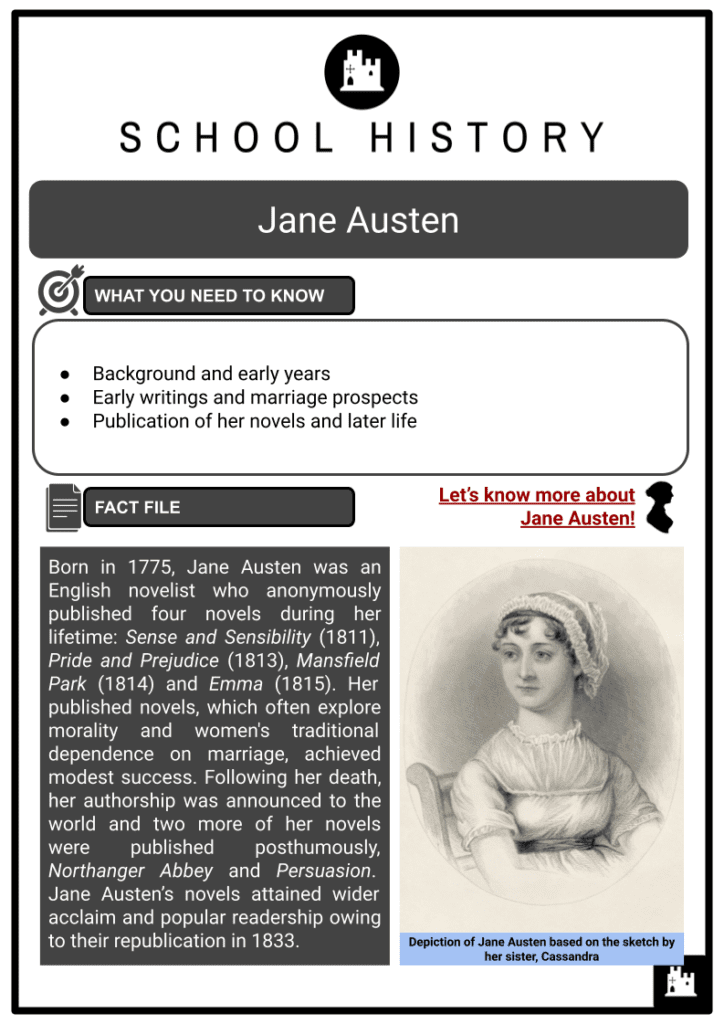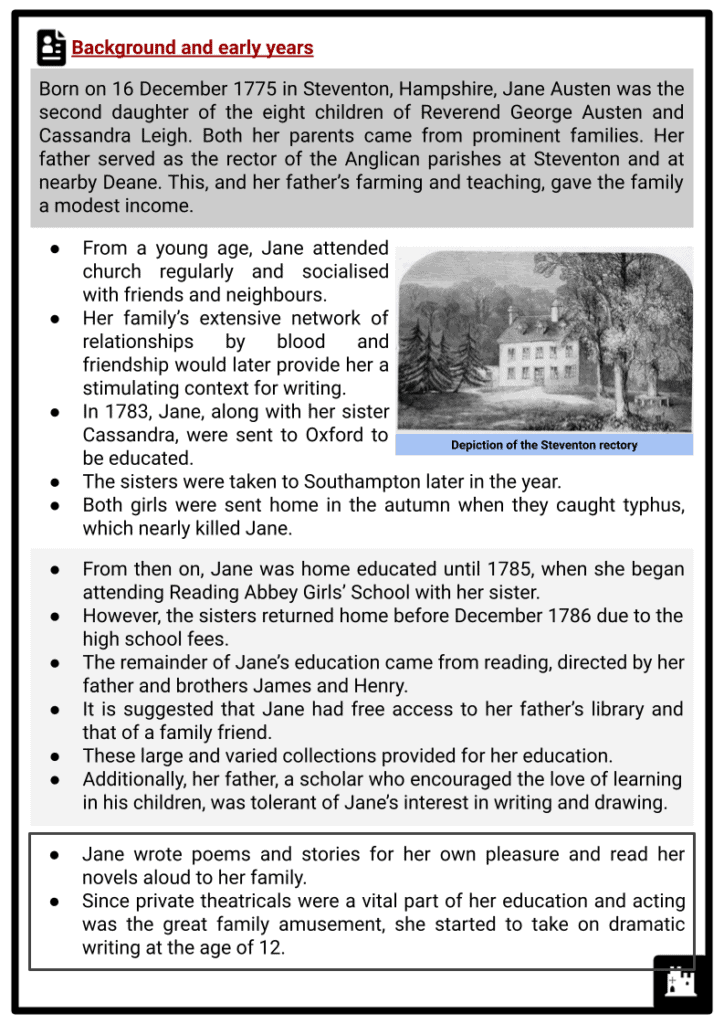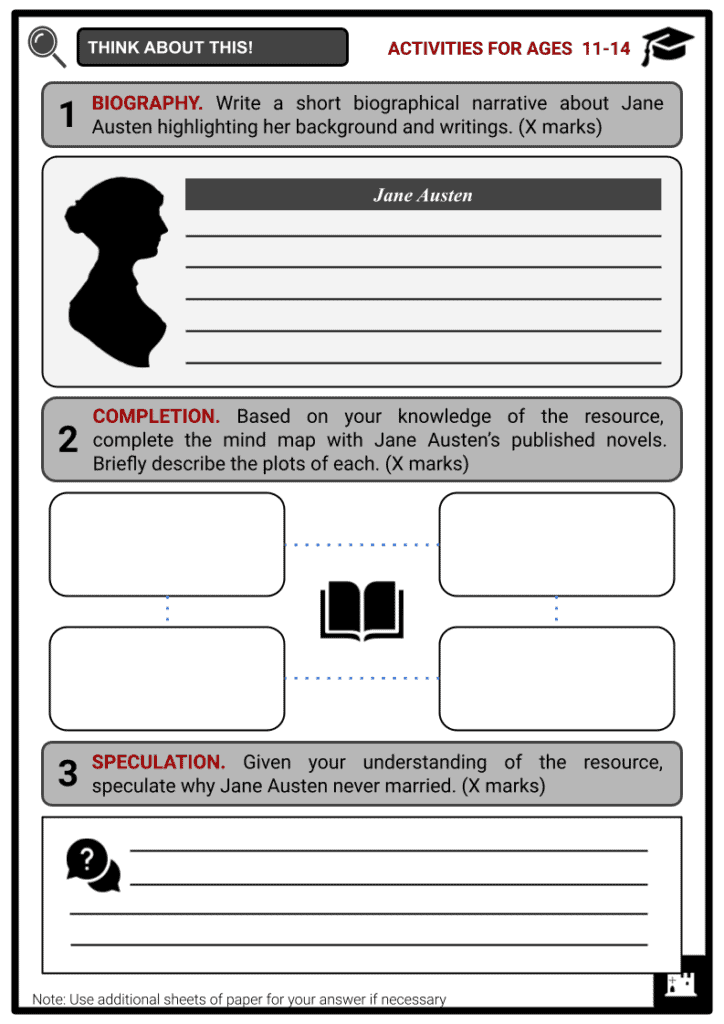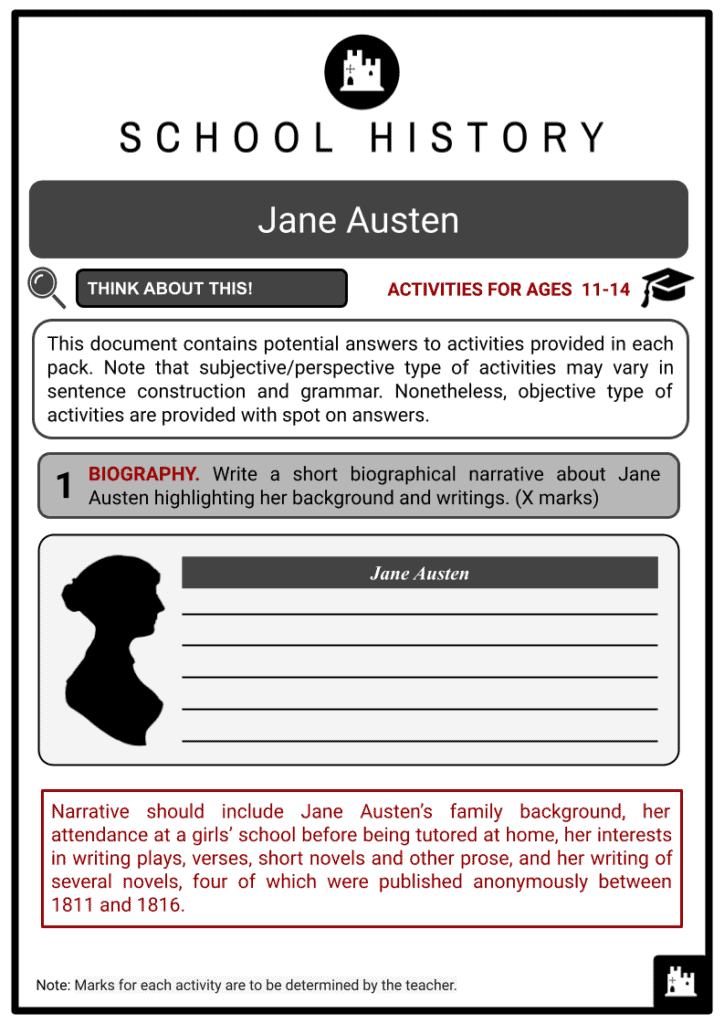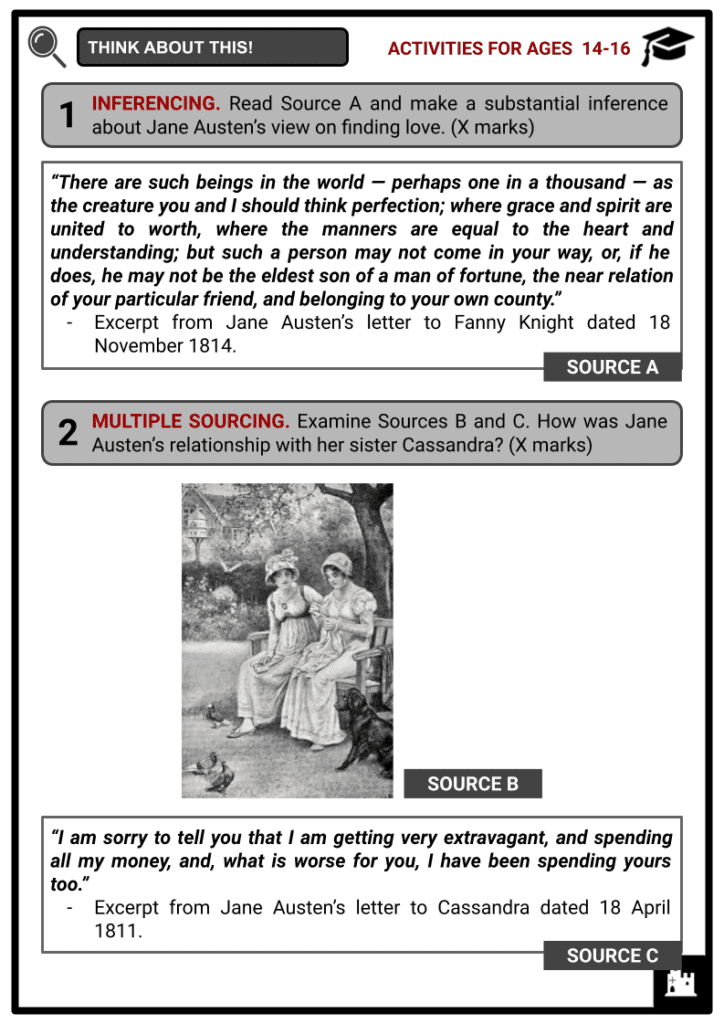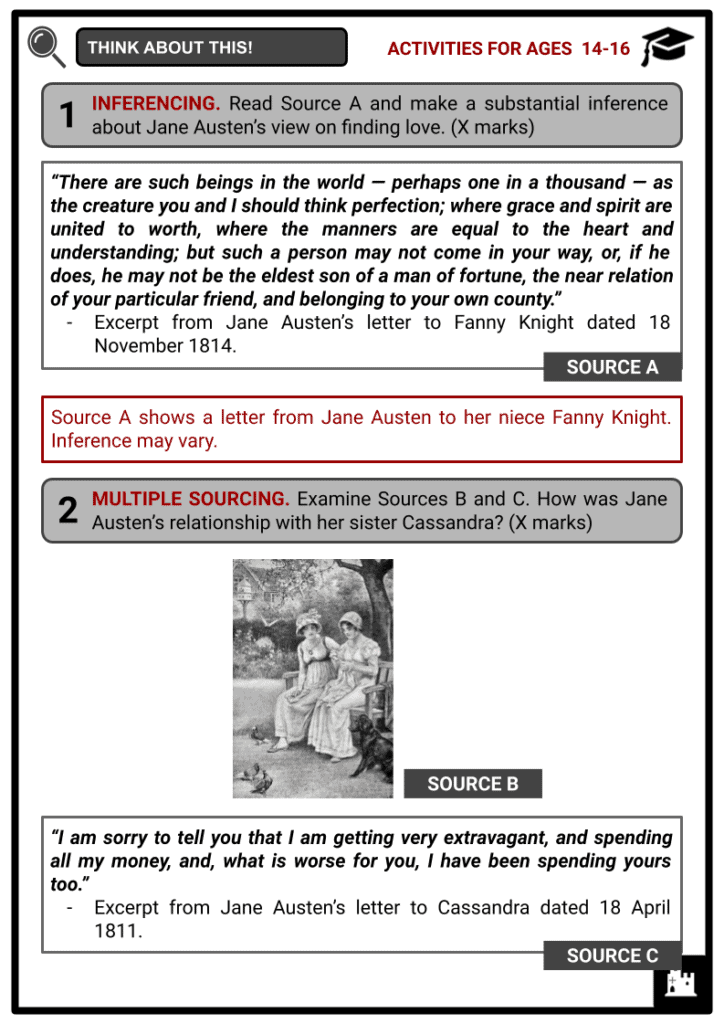Download Jane Austen Worksheets
Do you want to save dozens of hours in time? Get your evenings and weekends back? Be able to teach about Jane Austen to your students?
Our worksheet bundle includes a fact file and printable worksheets and student activities. Perfect for both the classroom and homeschooling!
Table of Contents
Add a header to begin generating the table of contents
Summary
- Background and early years
- Early writings and marriage prospects
- Publication of her novels and later life
Key Facts And Information
Let’s know more about Jane Austen!
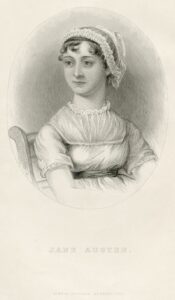
- Born in 1775, Jane Austen was an English novelist who anonymously published four novels during her lifetime: Sense and Sensibility (1811), Pride and Prejudice (1813), Mansfield Park (1814) and Emma (1815). Her published novels, which often explore morality and women's traditional dependence on marriage, achieved modest success. Following her death, her authorship was announced to the world and two more of her novels were published posthumously, Northanger Abbey and Persuasion. Jane Austen’s novels attained wider acclaim and popular readership owing to their republication in 1833.
Background and early years
- Born on 16 December 1775 in Steventon, Hampshire, Jane Austen was the second daughter of the eight children of Reverend George Austen and Cassandra Leigh. Both her parents came from prominent families. Her father served as the rector of the Anglican parishes at Steventon and at nearby Deane. This, and her father’s farming and teaching, gave the family a modest income.
- From a young age, Jane attended church regularly and socialised with friends and neighbours.
- Her family’s extensive network of relationships by blood and friendship would later provide her a stimulating context for writing.
- In 1783, Jane, along with her sister Cassandra, were sent to Oxford to be educated.
- The sisters were taken to Southampton later in the year.
- Both girls were sent home in the autumn when they caught typhus, which nearly killed Jane.
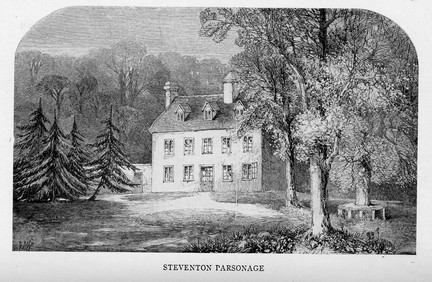
- From then on, Jane was home educated until 1785, when she began attending Reading Abbey Girls’ School with her sister.
- However, the sisters returned home before December 1786 due to the high school fees.
- The remainder of Jane’s education came from reading, directed by her father and brothers James and Henry.
- It is suggested that Jane had free access to her father’s library and that of a family friend.
- These large and varied collections provided for her education.
- Additionally, her father, a scholar who encouraged the love of learning in his children, was tolerant of Jane’s interest in writing and drawing.
- Jane wrote poems and stories for her own pleasure and read her novels aloud to her family.
- Since private theatricals were a vital part of her education and acting was the great family amusement, she started to take on dramatic writing at the age of 12.
Early writings and marriage prospects
- Between 1787 and 1793, Jane wrote a large body of material, which she compiled into three bound notebooks. She called the three notebooks Volume the First, Volume the Second and Volume the Third. These are now referred to as the Juvenilia.
- Jane’s early works include plays, verses, short novels, and other prose, which commonly parodied sentimental novel and sentimental comedy.
- At around eighteen years old, she started to write longer, more extravagant works, such as Lady Susan, a short epistolary novel written between 1793 and 1795.
- When Jane became an aunt, she sent her nieces selections of prose works and anthologies to serve as a guide and instructions for the “conduct of young women”.
- At age twenty, Jane was introduced to Tom Lefroy, the Irish nephew of a family friend who had just finished a university degree and was moving to London for training as a barrister.
- Although it is suggested that both were genuinely attracted to each other, marriage was impractical since neither of them was financially independent at the time.
- Jane was also believed to have accepted a marriage proposal from Harris Bigg-Wither, the 21-year-old heir of a Hampshire family, in December 1802.
- However, this marriage did not go through as Jane broke off the engagement.
- Despite Jane having never married, she went on to write about love and marriage in her novels.
Publication of her novels and later life
- After finishing Lady Susan in around 1795, Jane started writing full-length novels one after another.
- She finished writing Elinor and Marianne before 1796, and according to her sister, it was told through a series of letters.
- She began a second novel, First Impressions, and completed its initial draft in August 1797.
- Her father attempted to have one of her novels published but was declined by an established publisher in London.
- Following the completion of First Impressions, Jane revised Elinor and Marianne heavily between November 1797 and mid-1798. This version was of third-person narration.
- She started a third novel entitled Susan during the middle of 1798 and completed it about a year later.
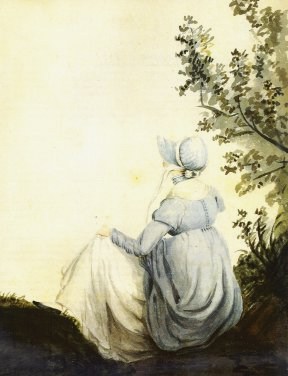
- In December 1800, Jane’s father announced his retirement from the ministry, moving his family to Sydney Place in Bath.
- In early 1803, Henry Austen offered Jane’s third novel to Crosby & Company, who paid £10 for the copyright.
- The publisher promised early publication and advertised Susan but never published it.
- While living in Bath in 1804, Jane began but abandoned her new novel The Watsons.
- It is suggested that Jane chose to stop work on the novel following her father’s death in January 1805.
- The sudden death of Jane’s father left Jane, Cassandra (also unmarried) and their mother financially insecure.
- Her brothers, Edward, James, Henry and Francis, vowed to provide annual contributions to support them.
- For the next four years, the family’s living arrangements reflected their unstable financial situation.
- They moved to rented quarters in Bath and then to Steventon and Godmersham.
- In 1806, the family moved to Southampton, visiting various branches of the family.
- Around early 1809, Jane’s brother Edward offered a large cottage in Chawton village to Jane, Cassandra and their mother.
- They moved into the Chawton cottage in July 1809 and lived a very quiet life there.
- During her time in Chawton, Jane considered publishing her books anonymously, like many female authors at the time.
- She published four generally well-received novels with plots that often delve into the dependence of women on marriage in the pursuit of favourable social standing and economic security.
What were Jane Austen’s published novels?
- Sense and Sensibility
- Published in 1811, it is said to have been initially given the title Elinor and Marianne before Jane changed its form to a narrative. On its title page, ‘By A Lady’ appears where the author’s name might have been. The novel follows the story of the Dashwood sisters as they come of age. It sold out its first print run of 750 copies in the middle of 1813, providing Jane with some financial independence.
- Pride and Prejudice
- Published in 1813, it is a revision of First Impressions. On its title page, it was mentioned that it was attributed to ‘the Author of Sense and Sensibility’. It follows the character development of Elizabeth Bennet. By October 1813, Thomas Egerton, its publisher, was able to begin selling a second edition, having sold out its first edition owing to its wide advertisement.
- Mansfield Park
- Published in 1814, it was very popular with readers despite being ignored by reviewers at the time. It tells the story of Fanny Price as she navigates her adolescence and young adulthood. All copies of the novel were sold within six months. Jane’s earnings from this novel were larger than for any of her other novels. However, its second edition in 1816 did poorly.
- Emma
- Published in 1815, it follows the story of Emma Woodhouse as she meddles in the love lives of friends and neighbours. It sold well and was Jane’s last novel to be published during her lifetime.
- Whilst her novel Emma was being prepared for publication, Jane completed the first draft of The Elliots in 1816, published as Persuasion posthumously.
- In the same year, Jane’s brother Henry was able to repurchase the copyright for Susan from Crosby & Company.
- However, due to the family’s financial troubles, Jane was forced to abandon publishing either of these completed novels.
- By early 1816, her decline due to a fatal illness was unmistakable.
- In spite of her illness, she continued writing The Elliots and looked again at the manuscript of Susan, published as Northanger Abbey posthumously.
- In January 1817, she began Sanditon but it remained unfinished because of her deteriorating health.
- In May, she was taken to Winchester to be placed under the care of an expert surgeon.
- On 18 July, Jane died at the age of 41 and was buried in Winchester Cathedral six days later.
- In December 1817, Henry, who arranged for the publication of Northanger Abbey and Persuasion, announced Jane’s authorship to the world.
- In 1833, Richard Bentley, who had purchased the remaining copyrights to all of Jane’s novels, released the first collected edition of her works.
- Jane’s novels eventually gained wider acclaim and popular readership and have been continuously in print.
- The lasting popularity of her books can be seen in a great number of film and television adaptations of her work.

